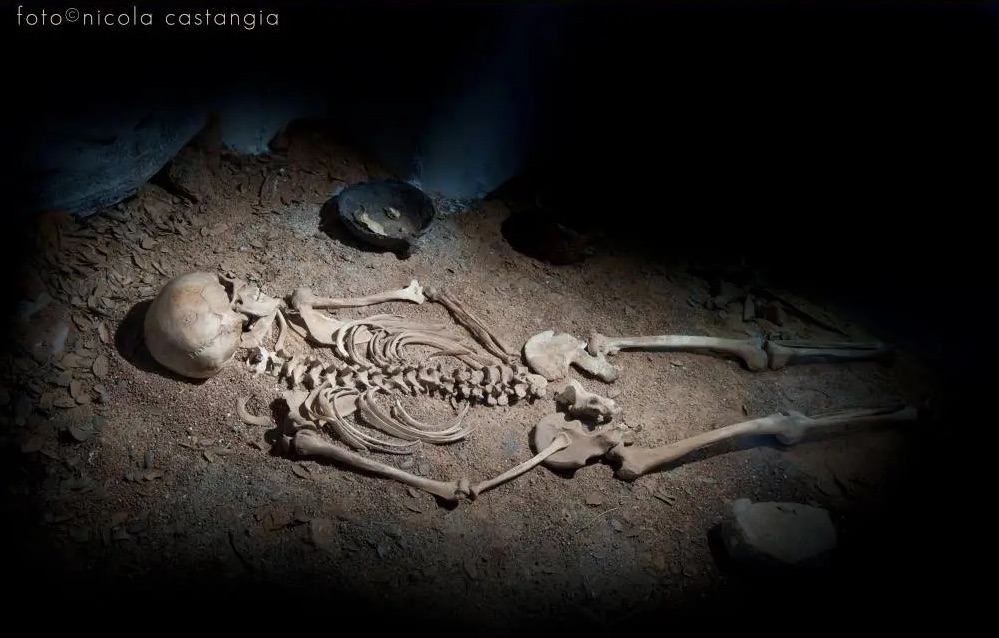Sisaia, Six Times Grandmother 0 Comments

We already talked about Supramonte, which is the heart of Sardinia, hard as granite and velvety like the air you breathe, scented with earth, flowers, grass and stone. An extraordinary nature shaped by enormous limestone masses that have opened up almost forming a defence to the beautiful Lanaitho valley.
In a Supramonte’s cave, of the Lanaitho valley in the early 1960s the Nuorese Cave Group found... but let us have Nicola Castangia tell us about it, a Sardinian image artist who shoots his motherland with respectful love, and was the first one to photograph Sisaia: “She was resting in a cave in Supramonte, in the Lanaitho valley, when she was disclosed in 1961 Spring. Inside the cave, near the fireplace remains, laid the skeleton of a woman. They affectionately called her “Sisaia”. A single burial had been reserved for her, perhaps because she was a princess.”
Around the skeleton they also found ancient tomb objects consisting of some bowls, bone awls and other typical objects confirming that it was a burial cave used in very remote times as hypothesised by speleologists.
It was a great discovery and it is awesome imagining that night, with a strong scent of verbena, myrtle and helichrysum in the air, the valley also participating with the speleologists’ fulfilment, illuminated by the translucent light of the full moon, showing off its mysterious and splendid beauty.
By examining the human remains it was determined that she was a woman. So, Bruno Piredda, at that time president of the Nuorese Cave Group, decided to give her a name and the first endearment name coming to his mind was "Iaia", grandmother, but then, given the age of that grandmother, he decided on the name "Sisaia" (Sexies Avia), of Latin tradition, six times grandmother.
What made Sisaia very interesting from an archaeological point of view was a hole on the skull made with a fine surgical technique, a perforation made using a cylindrical drill, with extraction and subsequent re-positioning of the bone disk, with survival of the operated person and consequent perfect healing. This is what makes Sisaia so fascinating, first and foremost for science, because this difficult operation was performed in 1.600 BC, testifying that in Sardinia there were people who also excelled in surgical skills.
Marina Moncelsi, teacher and writer, offers a fascinating imaginary reconstruction of Sisaia's life, which I will try to summarise.
Sisaia, daughter of the king, was the Moon Goddess, having the task of interpreting the Earth and Water Signs. Was a very burdensome gift to bear, especially since she had fallen into a crevasse while gathering herbs to make medical ointments.
Soulless, she was taken to the best shaman who gave her oblivion and tied her with leather strips, because once oblivion was over the pain would have been massive. The wiseman, aware of the value of the princess’ life consecrated to the Great Mother, made a cut with sharp flint, on her previously shaved head, which allowed him to detach the skin from the skull. After outlining the bone, he used a flint with a rounded cutting edge like a saw. He removed the bone fragment using a small lever: a squirt of bluish and semi-coagulated humour splashed out accompanied by the girl's scream. The shaman, murmuring ritual dirges, perfectly cleaned the space where the liquid had previously been, while an assistant cleaned the bone washer taken out. The shaman placed the bone fragment back in its natural location, brought the edges of the scalp back together and stitched them up.
The Princess was healed but profoundly renewed, because the strength of a very powerful spirit had settled in her brain during the operation. That unnatural power, the ability to predict the events of nature and men led the wisemen to confer her the command and the ancient amulets of shaman healers... and to assign her a single burial.
Today “Sisaia” is located at the National Archaeological Museum of Nuoro, with the entire contents of the original tomb. A larger glass case was designed so that she can be fully admired from all angles.
“To forget one’s ancestors is to be a brook without a source, a tree without a root.” (Cit.)
--Written by Daniela Toti
Photo by Nicola Castangia
Share your opinion with us!